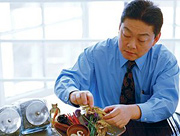Top 5 Herbal Formulas for Health and Wellness
By Dr. Stephanie Pina and Dr. Dan Wen
Why do the Chinese have a reputation for living long, healthy lives? A rich history of using Chinese herbs may play a role. Here are five of the most popular herbal formulas and how they help promote health and wellness in the body.
Modern Western pharmacology tends to focus on finding the single molecule that cures a disease. In contrast, Chinese medicine often utilizes herbal formulas that blend many agents to address underlying imbalances that may cause disease, while aiding in symptom relief - a "shotgun" approach that has been practiced in Asia for thousands of years. Medical practitioners all over the world have begun to incorporate more Chinese formulas into their practices to treat common, everyday conditions. Whereas raw herbs were once sent home with the patient and made into teas, today there are a variety of forms available over the counter, in practitioners' offices and in health food stores.
Herbal Theory at a Glance
According to Chinese medicine, herbs and formulas have affinities to certain organ channels. Each herb has significance in a formula, similar to the way a pharmaceutical medication has a specific action. An herb can affect multiple organ systems, making its way through the body to help restore balance. It has been suggested that early Chinese herbalists could follow the energy of herbs through the body, which helped determine their medicinal function.
 Chinese medicine has become much more mainstream in its use and indications. Over-the-counter products are now used based on their modern-day disease indications, and are used in their traditional applications for treating imbalances in organ channels. While modern medicine has tried to extract the most active components of herbs in an attempt to enhance their effects, Chinese herbal formulas continue to combine whole herbs. It is common to see herbs and minerals such as licorice, ginger, simple sugar, rice and salt added to help make the other components in a formula work better. Often, simple base formulas are used together or individual herbs are added. Here are five common Chinese herbal formulas that address basic health issues.
Chinese medicine has become much more mainstream in its use and indications. Over-the-counter products are now used based on their modern-day disease indications, and are used in their traditional applications for treating imbalances in organ channels. While modern medicine has tried to extract the most active components of herbs in an attempt to enhance their effects, Chinese herbal formulas continue to combine whole herbs. It is common to see herbs and minerals such as licorice, ginger, simple sugar, rice and salt added to help make the other components in a formula work better. Often, simple base formulas are used together or individual herbs are added. Here are five common Chinese herbal formulas that address basic health issues.
A Basic Formula
(Gui Zhi Tang)
 This formula's traditional use stems back to the classics, where it was one of the first formulas used to fight off signs of the common cold. It works by pushing pathogens out of the body, primarily through sweating. This formula has been modified to be a component of so many formulas that many modern patent medicine books do not recognize it individually as a formula. The major ingredient, cinnamon, has an overall immune-boosting quality that helps promote the movement of other herbs through channels.
This formula's traditional use stems back to the classics, where it was one of the first formulas used to fight off signs of the common cold. It works by pushing pathogens out of the body, primarily through sweating. This formula has been modified to be a component of so many formulas that many modern patent medicine books do not recognize it individually as a formula. The major ingredient, cinnamon, has an overall immune-boosting quality that helps promote the movement of other herbs through channels.

